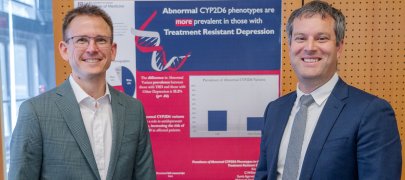Using Big Data to Prevent Cardiac Arrhythmias
As many as two-thirds of elderly patients admitted to acute-care settings are exposed to multiple medications known to interfere with the ability of the heart to “recharge” between beats, which could lead to a life-threatening form of cardiac arrhythmia.
Although a rare health occurrence, more than 150 common medications — including azithromycin and ondansetron — can contribute to prolonged heart-recharging intervals, which may lead to serious complications and/or longer hospital stays.
To address this problem, University of Arizona researchers will implement alerts embedded in patients’ electronic health records to estimate risk and to assist health-care providers in mitigating sudden cardiac death.
Funded by a two-year, $766,000 grant from the Agency for Healthcare Research and Quality, the project uses health information technology to support maximum safety and effectiveness of medicines for patients who are more likely to be affected. The team will work within 28 Banner Health facilities throughout Arizona, California, Colorado, Nebraska, Nevada and Wyoming.

The project will use electronic health records and prescribing systems to identify patients at high risk of harm from medications and immediately send electronic messages to advise doctors of the risk and how to prevent the development of potentially life-threatening heart rhythm disorders and sudden death.
The grant also will fund educational programs to inform health care providers how to best utilize and respond to the computer-generated advisories.
“We are excited to have this opportunity to work closely with Banner Health data scientists and to evaluate a medication safety program within the entire health-care system,” said Daniel Malone, PhD, scientific leader for the grant and a professor at the UA College of Pharmacy with a joint appointment in the UA Mel and Enid Zuckerman College of Public Health.
The project builds on data that already is captured in patents’ electronic medical records, including data that is imported automatically from the hospital’s electrocardiogram equipment.
“In addition to making this alert as specific and precise as possible, we will conduct usability testing to ensure it works in the provider’s workflow,” said Corneliu Antonescu, MD, clinical assistant professor in the Department of Biomedical Informatics at the UA College of Medicine – Phoenix and a physician informatist with Banner Health.
The research team also includes other UA faculty members, including Raymond Woosley, MD, PhD, co-director of the Division of Clinical Data Analytics and Decision Support at the UA College of Medicine - Phoenix; Tyler Gallo, PharmD, assistant professor, pharmacy practice and science, from the UA College of Pharmacy and UA College of Medicine - Phoenix; and Sheila Gephart, PhD, RN, associate professor with the UA College of Nursing. Assisting in the project is Jim Tisdale, PharmD, professor of pharmacy practice with Purdue University College of Pharmacy.
This project is supported by grant No. R18HS026662 from the Agency for Healthcare Research and Quality. The content is solely the responsibility of the authors and does not necessarily represent the official views of the Agency for Healthcare Research and Quality.
A version of this article originally appeared on the UA College of Pharmacy website.
About the College
Founded in 2007, the University of Arizona College of Medicine – Phoenix inspires and trains exemplary physicians, scientists and leaders to optimize health and health care in Arizona and beyond. By cultivating collaborative research locally and globally, the college accelerates discovery in a number of critical areas — including cancer, stroke, traumatic brain injury and cardiovascular disease. Championed as a student-centric campus, the college has graduated more than 800 physicians, all of whom received exceptional training from nine clinical partners and more than 2,700 diverse faculty members. As the anchor to the Phoenix Bioscience Core, which is projected to have an economic impact of $3.1 billion by 2025, the college prides itself on engaging with the community, fostering education, inclusion, access and advocacy.


